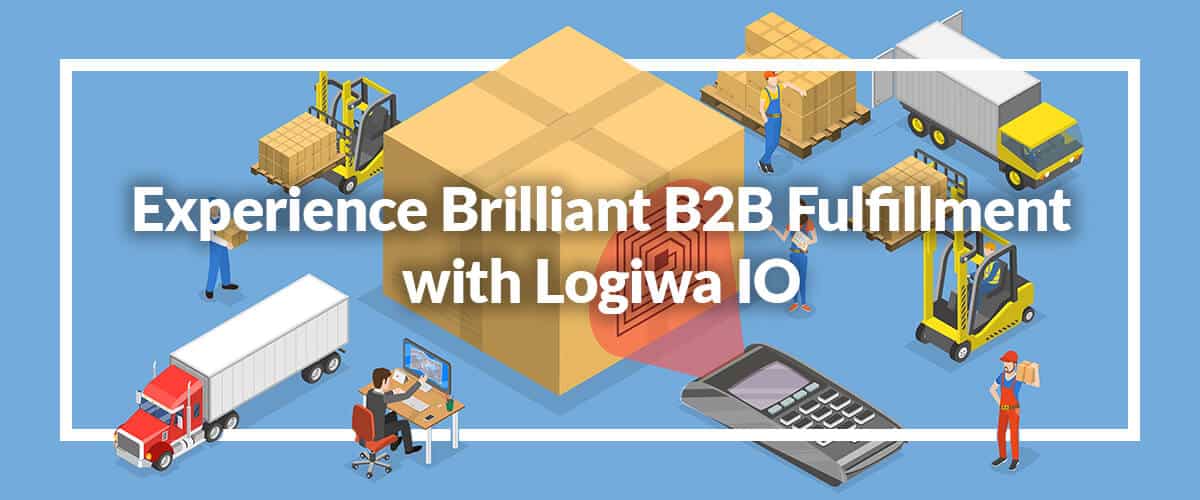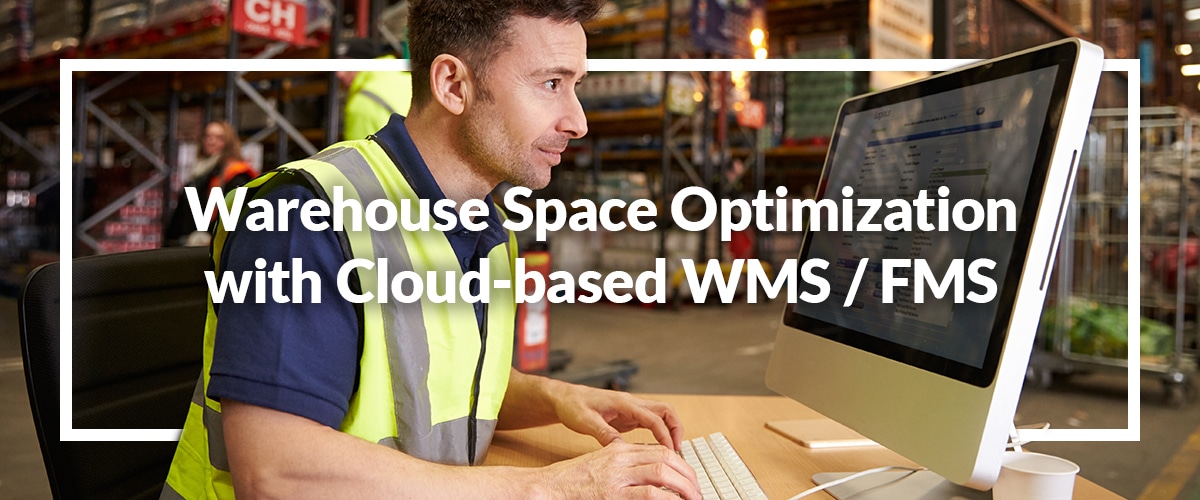Behind The Scenes of Amazon Inventory Management
Originally published on October 11, 2023 by Logiwa Marketing, Updated on December 1, 2023
Key Takeaways:
- Amazon’s Owned Warehouses and Inventory Control: Unlike many retailers, Amazon stores most of the items sold on its platform in its own warehouses, totaling 288 million square feet of space as of 2018. This allows for more control and efficient management of inventory.
- Speed of Customer Demand and Delivery: Amazon constantly focuses on reducing delivery times to meet customer expectations. This involves strategic investments in logistics and a complex, but effective warehouse management system that enables quick product retrieval and delivery.
- Amazon’s Facility Types and Their Roles: Amazon’s distribution network consists of several types of facilities including Crossdock centers, Fulfillment centers, Sortation centers, Delivery stations, and Amazon Prime Now hubs. Each plays a unique role in ensuring timely delivery of orders.
- Innovation in Amazon Fulfillment Centers: Amazon employs a seemingly chaotic but efficient system of inventory management where items are stowed wherever there is space available in the fulfillment centers. This unique approach, coupled with state-of-the-art technology and robotics, enhances the speed and efficiency of the order picking process.
- Optimizing Inventory as an FBA Customer: If you’re an Amazon FBA customer, understanding and adhering to Amazon’s stringent preparation, labeling, and packing requirements will ensure your products are processed quickly and efficiently. This ultimately contributes to better inventory management and customer satisfaction.
Amazon is arguably the most successful ecommerce company today. What started as an online bookstore has become an ecommerce giant with its own distribution network that poses a threat to retailers and courier services alike. In 2006, the company launched Fulfillment by Amazon (FBA). This essentially monetized Amazon inventory management and its incredible logistics network so that small business owners could benefit from the network of a big corporation without the headaches of a big corporation.
But, how does its distribution network function? And how can business owners get the most out of the Amazon FBA services while entrusting their stock to Amazon?
We’re going to break it all down for you.
In our Amazon Inventory Management System guide, we’ll help you understand:
- The Power of Amazon’s Owned Warehouses and Extensive Inventory Control
- Delivering at the Speed of Customer Demand: Amazon’s Solution for Fast Delivery
- Unveiling the Vital Role of Amazon’s Facilities in Operational Excellence
- Inside the Engine of Efficiency: How Amazon Fulfillment Centers Manage Inventory
- Embracing Order from Chaos: How Amazon’s Fulfillment Centers Drive Success
- Warehouse Robotics In Amazon Fulfillment Centers
- How Amazon’s Sortation Centers Keep The System Moving
- What Is The Amazon System for FBA Customers?
- How To Properly Prepare and Manage Your Amazon Inventory As An FBA Customer
- Amazon Inventory System Presents Opportunities and Lessons For Any Business Owner
BONUS: Before you read further, download our whitepaper to see how Logiwa uses real-time tracking to help customers get up to 100% inventory accuracy and increase shipments by 2.5x.
The Power of Amazon’s Owned Warehouses and Extensive Inventory Control
Many retailers, both physical and online, don’t run their own warehouses. While they may have their own backrooms, their major products are stored in a warehouse space that they lease or rent. To fulfill orders, third-party transportation companies ship the goods to customers or to the companies’ retail stores.
For Amazon, this isn’t a concern. Amazon stores the majority of the stuff it sells on its platform and, increasingly, the stuff other businesses sell on its platform. In other words, the company manages a gargantuan amount of space. By the end of 2018, Amazon owned 288 million square feet of space, warehouse space included. Two-thirds of this property footprint is in North America.
Of course, at the center of Amazon’s success is a focus on scalability and customer satisfaction. It knows what satisfies customers about online shopping: instant gratification. (Or sooner rather than later gratification, to be more realistic.) From the beginning, Amazon understood that one of the biggest challenges to ecommerce is a consumer’s desire to get their hands on a product instantly, the way they can from a brick-and-mortar store.
Delivering at the Speed of Customer Demand: Amazon’s Solution for Fast Delivery
It focused on continuously reducing its delivery times. Most Amazon users have become accustomed to two-day delivery while some areas even have access to same-day delivery, which gives physical retailers a run for their money.
So, how has Amazon managed to pull this off while other ecommerce retailers struggle with fast shipping?
From a strategic point of view, the answer is that Amazon has always invested in delivering the best customer experience possible. While other retailers were content to keep delivery times long (and weren’t being forced by the competition to speed up), Amazon pushed forward with figuring out quick delivery. As a result, they’ve become the standard that other companies are scrambling to meet.
Perhaps more interesting to you though is that from a logistics point of view, the answer is about transportation and warehouse management. Transportation affects the delivery time for obvious reasons. If you have a warehouse in New York, it takes time to move an order to a customer in Georgia.
A less-obvious, but equally important, challenge to quick delivery is actually finding the right items within the warehouse in order to ship them out to customers. This process—the order picking process—is traditionally a labor-intensive activity.
Amazon set itself up to succeed in both of these logistics arenas.
Unveiling the Vital Role of Amazon’s Facilities in Operational Excellence
As mentioned above, Amazon manages a lot of land and much of this land consists of warehouse space. Since Amazon is Amazon, it doesn’t approach warehouse management in a monolithic manner. It’s created a thoughtful warehouse ecosystem to add structure to the Amazon system.
In fact, a better way to think of this ecosystem is as a distribution network.
The Amazon system divides its distribution network into 5 types of facilities:
- Crossdock centers: Packages from foreign vendors remain here until more stock is required by the fulfillment centers.
- Fulfillment centers: This is the sort of environment a warehouse professional would be most familiar with. This is where Amazon stores its goods, and it’s also where Amazon workers pick and pack products for customers. The company operates more than 175 fulfillment centers globally.
- Sortation centers: Introduced in 2014, sortation centers are meant to improve “last mile delivery.” No product is held at these locations. Instead, prepared customer packages move through conveyor belts while Amazon associates and robots sort and route the packages by zip code before they are sent to a carrier for final delivery.
- Delivery stations: Delivery stations are Amazon’s way of owning “last mile delivery” in its distribution system. The last mile of many Amazon deliveries are handled by USPS, FedEx, or UPS, and delivery stations give Amazon flexibility in areas with a high volume of orders.
- Amazon Prime Now hubs: The Amazon system for time-sensitive items, like groceries, relies on Prime Now hubs. These hubs manage items that are typically delivered within 2 hours of purchase.
The two facility types that are most critical to the Amazon inventory management are the fulfillment centers and the sortation centers.
Inside the Engine of Efficiency: How Amazon Fulfillment Centers Manage Inventory
Warehouses operate on an extreme version of that kindergarten lesson: Everything in its place and a place for everything. The standard stock management wisdom is to divide your warehouse and its shelves into sections and put away items accordingly.
For 99% of businesses, this is the way to go. If you simply placed SKUs onto the first shelf you came across, you’d be hard pressed to find that item again when a customer orders it.
Amazon falls into the other 1% of businesses. It would be safe to assume that Amazon is not running its trillion-dollar business using spreadsheets or off-the-shelf inventory management system. Rather, it uses a highly sophisticated warehouse management system to keep its processes running smoothly. This sophisticated system allows the company to embrace the chaos inherent in running a small country’s worth of space.
You might be surprised to learn that Amazon fulfillment centers are not sectioned off in any discernible way. There isn’t a consumer electronics section or a kitchen appliances section. When a shipment of batteries comes in, an associate doesn’t find the batteries section on a warehouse map and then walk over to that section. Instead, when goods come into a fulfillment center, associates place them wherever there’s space.
And it’s one of the main reasons Amazon delivers goods to its customers so quickly.
BONUS: Before you read further, download our Warehouse Management Software Whitepaper to see how Logiwa uses real-time tracking to help customers get up to 100% inventory accuracy and increase shipments by 2.5x.
Embracing Order from Chaos: How Amazon’s Fulfillment Centers Drive Success
Here’s a breakdown of how the Amazon warehouse system manages an incoming order of goods:
- A box of toothpaste arrives to the Amazon fulfillment center
- An associate removes each individual tube from the box
- The associate proceeds to place each individual tube wherever there’s available space, with no rhyme or reason (aside from the reason that there’s a free spot)
- Before placing each item in its random location, the associate scans the barcode on the shelf and on the product
- The system can now instantly identify where those 50 tubes of toothpaste are scattered
This system benefits Amazon’s model in several ways.
Quick Putaway Process
It’s easy for associates to put items away. Rather than using directed putaway and crossing the entire warehouse to put away a box of toothpaste, associates can quickly put items in the first available spot they come across.
Efficient Order Picking Process
If you have a dedicated area for toothpaste, you’ll have to walk across the entire aisles when an order for toothpaste comes in. With the Amazon order fulfillment system, there’s a greater chance that one of those fifty tubes of toothpaste are closer to your current location, making it efficient for you to grab one and continue with your picking path.
Randomness is Sensible for The “Everything” Store
Because people can buy almost anything on Amazon, it would be virtually impossible to store specific quantities of every possible item. At any given moment, Amazon may only have one box of Oreos in its DC. If Amazon carried a large quantity of every item (e.g., it created a dedicated section for Oreos), it would have to keep a whole section e empty while it waited for a shipment of cookies, which would severely limit the amount of storage space and would require an investment in more warehousing space.
Unpacking Makes Sense in a B2C Environment
If Amazon were supplying Wal-Mart stores or CVS locations, it would make sense to keep the 50 tubes of toothpaste in their boxes. But, since Amazon mostly serves consumers, it makes sense to unpackage these items in advance rather than wait for an order to come in.
You may also like :With Amazon Buy Shipping, say hi to the savings on time and money for shipping labels. To learn more about the requirements, benefits, and preferences of the service, check our Amazon buy shipping blog post.
Warehouse Robotics In Amazon Fulfillment Centers
In some fulfillment centers, robots work alongside human workers. Conceptually, the “chaotic” process is the same, but the robots add some speed. For example, in robot-equipped fulfillment centers, robots bring shelves to workers instead of workers looking for shelves. It’s essentially a faster version of Amazon’s randomized putaway system.
How Amazon’s Sortation Centers Keep The System Moving
In sortation centers, prepared and sealed customer packages move through conveyor belts, are routed based on their destination zip code, and are eventually shipped to post offices. The purpose is to get packages to customers faster and address the challenges of same-day delivery.
While the goal of these sortation facilities is admirable, the inner workings of these centers are beyond impressive.
In one such center in the Denver area, warehouse robots known as “drives” carry packages. Once a worker places a package on a robot, the robot reads the barcode and then takes off to one of the 300-plus rectangular holes in the floor, which represent zip codes. The package slides off the robot’s back and down a chute where it’s loaded onto a truck and is out for delivery.
There are also human workers who carry out this process. They grab packages, quickly look at the address, and walk them over to the appropriate chute. It’s easy to see how the robots speed up the process of sorting packages, and they even politely pause to make room for other robots, avoiding collisions and potential damage to products. The entire system is calibrated by experts who run a series of simulations to determine the exact speed at which the robots move and which robots get the right of way.
Whereas fulfillment centers consist of workers who can use their human dexterity to pick up different-sized items and sort them (a skill robots struggle with), sorting centers consist of “mules” that quickly move these packaged items to their appropriate shipping truck.
The fulfillment centers and the sortation centers address two key system challenges: Finding goods and getting them on the road quickly.
You may be interested: For detailed information about Amazon Seller Central and Amazon Vendor Central, check out our article.
What Is The Amazon System for FBA Customers?
There’s another dimension to Amazon’s system: managing goods for its Fulfillment by Amazon (FBA) customers.
Since Amazon has one of the most sophisticated fulfillment systems in the world, it makes sense that other businesses would pay to leverage it. As a result, Amazon offers the FBA service where it picks, packs, and ships a business’s products on their behalf.
Here’s how Amazon receives and manages an FBA customer’s products:
- Packages (properly sealed and with the appropriate labels) are received
- An Amazon associate scans the shipping label on the package to match it to a shipment ID in the system and to verify that it’s at the right fulfillment center
- An Amazon associate opens the shipping box to remove the goods
- An Amazon associate verifies that each individual item in the box has a scannable barcode
- An Amazon associate inspects each item to assess whether it needs additional packaging to prevent damage either during storage or during outbound shipment
- Products are sent to the receiving station
- An associate at the receiving station performs a “six-sided check” to ensure the item isn’t damaged
- An associate at the receiving station performs a title verification
- Once these steps are completed, the item is officially received
- The unit gets routed to be stowed
This is the process if everything goes smoothly. However, there are cases where a shipment must be put aside and dealt with by an Amazon problem solver. When an Amazon problem solver has to address an issue, it delays the receipt of items and their submission into the system by anywhere from a couple of hours to a couple of days.
How To Properly Prepare and Manage Your Amazon Inventory As An FBA Customer
If you use FBA and want your items to move smoothly through the process, be mindful of the company’s prep, labeling, and packing requirements.
- Make sure to put goods into right box by using automated package type selection algorithms to optimize shipping cost.
- Make sure your goods are packaged properly and are ecommerce ready.
- Don’t tape or band together multiple boxes.
- Shipping boxes shouldn’t have any other scannable barcodes aside from the shipping label.
- Place shipping labels over flat surfaces. (If you place the shipping label over the box’s seam, it can be damaged during shipping or when the associate has to open the box.)
- If possible use packing slips to improve inventory accuracy.
- Use foam, air pillows, or full sheets of paper as packing material or dunnage. (Using dunnage like packing peanuts or shredding paper slows down the receiving process.)
- Ensure case-packed units only have barcodes on the individual units and not on the outer carton so that multiple items aren’t received as one unit.
Understanding how Amazon’s FBA system service works (and prepping your goods accordingly) ensures that your products are entered into the system in a timely fashion.
Amazon Inventory System Presents Opportunities and Lessons For Any Business Owner
Whether you want to learn from Amazon or use its logistics system to distribute your goods, there are plenty of lessons to soak up. The retailer has bucked standard management wisdom and re-invented how workers pick, pack, and ship products. Moreover, it’s invited other business owners to piggyback on its proven methods and grow their businesses as well.
No matter your relationship with Amazon, the Logiwa can support your fulfillment management needs. Schedule your WMS demo today.
Amazon Inventory Management: FAQs
What is Amazon inventory management?
Amazon inventory management refers to the process of efficiently storing, tracking, and fulfilling inventory within Amazon’s vast distribution network. It involves managing stock levels, optimizing warehouse operations, and ensuring timely delivery to customers.
How does Amazon’s distribution network function?
Amazon’s distribution network consists of various types of facilities, including fulfillment centers, sortation centers, crossdock centers, delivery stations, and Amazon Prime Now hubs. These facilities work together to receive, store, sort, and ship products, ensuring fast and efficient order fulfillment.
What is Fulfillment by Amazon (FBA)?
Fulfillment by Amazon (FBA) is a service offered by Amazon where businesses can store their inventory in Amazon’s fulfillment centers. Amazon handles the picking, packing, and shipping of products on behalf of the business, providing storage, order fulfillment, and customer service support.
How can business owners benefit from Amazon FBA services?
By leveraging Amazon FBA services, business owners can take advantage of Amazon’s extensive logistics network, access Prime customers, and offer fast and reliable shipping. FBA helps businesses save time and resources on order fulfillment, customer service, and storage, allowing them to focus on other aspects of their business.
How does Amazon own and manage its warehouses?
Amazon owns and operates its warehouses to store its vast inventory. These warehouses are strategically located across the globe to ensure proximity to customers and efficient order fulfillment. Amazon employs advanced warehouse management systems and utilizes robotics technology to optimize operations and streamline inventory management processes.
What is the role of Amazon’s facilities in its inventory management system?
Amazon’s facilities, such as fulfillment centers and sortation centers, play crucial roles in its inventory management system. They enable efficient storage, inventory tracking, order picking, and packing processes. These facilities ensure that products are readily available, organized, and shipped out to customers in a timely manner.
How do Amazon fulfillment centers manage inventory?
Amazon fulfillment centers manage inventory through a sophisticated warehouse management system. When goods arrive at a fulfillment center, they are placed in available space rather than specific sections. Associates scan barcodes to track the location of items within the center, allowing for quick putaway and efficient order picking processes.
Why does Amazon embrace chaos in its fulfillment centers?
Amazon’s fulfillment centers embrace chaos by not segregating items into specific sections. This approach enables faster putaway and more efficient order picking, as items can be stored in any available space. By using advanced inventory tracking systems, Amazon can quickly locate and retrieve items for order fulfillment.
How do warehouse robotics play a role in Amazon’s fulfillment centers?
In some Amazon fulfillment centers, warehouse robotics work alongside human workers. These robots assist in tasks such as bringing shelves to workers, speeding up the order picking process. They navigate the warehouse and collaborate with humans to optimize operations and improve efficiency.
What are Amazon sortation centers and how do they keep the system moving?
Amazon sortation centers are facilities designed to improve last-mile delivery. Packages are routed based on their destination zip codes within these centers. Amazon associates and robots sort and route the packages to the appropriate carrier for final delivery. Sortation centers help streamline the process and ensure packages reach customers faster.
What is the Amazon system for FBA customers?
The Amazon system for FBA customers allows businesses to send their inventory to Amazon’s fulfillment centers. Once received, Amazon handles the storage, order fulfillment, and shipping processes on behalf of the business. FBA customers can manage their inventory, track sales, and access customer support through the Amazon Seller Central platform.
Logiwa ecommerce fulfillment software pre-integrated with all your sales channels and order management platforms.
Inventory Management
Improve your inventory across your supply chain.




